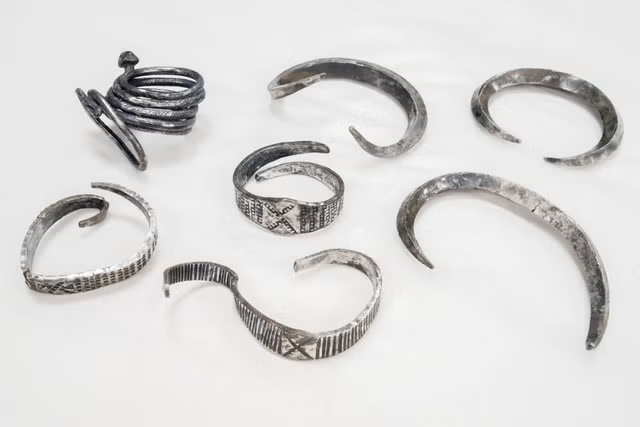One of the world's most venomous creatures could be a new source of inspiration for drugs to treat diseases affecting hundreds of millions of people, a new study suggests.
Led by researchers from the University of Utah, scientists have discovered a component within the venom of a sea snail that mimics a key human hormone involved in regulating blood sugar and hormone levels.
The findings, published in the journal Nature Communications, detail how a toxin from the geography cone snail, called consomatin, behaves similarly to somatostatin, a hormone responsible for keeping blood sugar and various other hormone levels in check.
Typically found in reefs in the tropical Indo-Pacific, geography cones are a type of predatory sea snail known for hunting small fish.
It's the most venomous of the known species of cone snail, with almost all human fatalities from cone snails attributed to them, according to research published in the International Journal of Clinical Pharmacology and Therapeutics.
But its deadly venom, when isolated, may have pharmaceutical potential. Unlike the natural human hormone somatostatin, consomatin is more stable and precise, making it a promising candidate for drug development.
"Human somatostatin binds to five different membrane receptors to elicit a myriad of physiological actions," Ho Yan Yeung, lead author and postdoctoral researcher at the University of Utah, told Newsweek. "However, the cone snail somatostatin-like toxin only binds to one of the five membrane receptors to produce its targeted effect."
The cone snail uses consomatin to paralyze its prey by preventing blood sugar levels from rising—a fatal mechanism for fish. The researchers believe this same property could help create better drugs for people with diabetes and hormone disorders.
Currently, synthetic drugs aimed at regulating hormone levels are important therapies but can come with side effects. Consomatin's pinpoint targeting could allow chemists to develop more effective treatments with fewer unintended consequences.
"We've been trying to do medicinal chemistry and drug development for a few hundred years, sometimes badly," Helena Safavi, associate professor of biochemistry at the University of Utah and senior study author, said in a statement. "Cone snails have had a lot of time to do it really well."
And the cone snail's venom is even more sophisticated than previously thought. The research team had already identified another venom component that mimics insulin, quickly lowering blood sugar in the snail's prey. Together, these toxins bring down blood glucose levels to dangerous lows and keep them there, making the prey nonresponsive.
"This paper basically showcases that our initial venom insulin discovery is not an outlier of venom peptides mimicking hormonal actions," Danny Hung-Chieh Chou, associate professor of pediatrics endocrinology at Stanford University, told Newsweek. Chou worked on the insulin mimicking study with Safavi but is independent of this study.
"Instead, there could be many more waiting to be discovered, and these could be potential life-saving therapies," he said.
Researcher Yeung agrees, stating in a press release: "It means that there might not only be insulin and somatostatin-like toxins in the venom. There could potentially be other toxins that have glucose-regulating properties too."
But you shouldn't expect to see consomatin-based drugs appearing on shelves anytime soon.
"Given its potent effects on suppressing glucose-lowering hormone, glucagon, especially when working together with insulin, we would predict there is a risk of low glucose episode," Yeung said.
Instead, by studying its structure, the team hopes to uncover other compounds that could work in a similar way to treat diseases tied to hormone disturbances.
As well as this, Yeung and the team are evaluating the therapeutic potential of cone snail toxins for use in pain management and metabolic disorders.
"There are so many interesting drug design inspirations from cone snail venom, or other venomous animals, that are yet to be uncovered," she said.
Despite the oddity of looking to a deadly snail for medical innovation, the research highlights how evolution has perfected mechanisms that scientists can now repurpose for human benefit.
"Cone snails are just really good chemists," Yeung said.
Do you have a tip on a science story that Newsweek should be covering? Do you have a question about climate change or nature? Let us know via science@newsweek.com.
References
Kohn AJ. Human injuries and fatalities due to venomous marine snails of the family Conidae. Int J Clin Pharmacol Ther. 2016 Jul;54(7):524-38. doi: 10.5414/CP202630. PMID: 27285461.
Yeung, H. Y., Ramiro, I. B. L., Andersen, D. B., Koch, T. L., Hamilton, A., Bjørn-Yoshimoto, W. E., Espino, S., Vakhrushev, S. Y., Pedersen, K. B., de Haan, N., Hipgrave Ederveen, A. L., Olivera, B. M., Knudsen, J. G., Bräuner-Osborne, H., Schjoldager, K. T., Holst, J. J., & Safavi-Hemami, H. (2024). Fish-hunting cone snail disrupts prey's glucose homeostasis with weaponized mimetics of somatostatin and insulin. Nature Communications, 15(1), 6408. https://doi.org/10.1038/s41467-024-50470-2
Xiong, X., Menting, J. G., Disotuar, M. M., Smith, N. A., Delaine, C. A., Ghabash, G., Agrawal, R., Wang, X., He, X., Fisher, S. J., MacRaild, C. A., Norton, R. S., Gajewiak, J., Forbes, B. E., Smith, B. J., Safavi-Hemami, H., Olivera, B., Lawrence, M. C., & Chou, D. H.-C. (2020). A structurally minimized yet fully active insulin based on cone-snail venom insulin principles. Nature Structural & Molecular Biology, 27(7), 615–624. https://doi.org/10.1038/s41594-020-0430-8
Disclaimer: The copyright of this article belongs to the original author. Reposting this article is solely for the purpose of information dissemination and does not constitute any investment advice. If there is any infringement, please contact us immediately. We will make corrections or deletions as necessary. Thank you.



